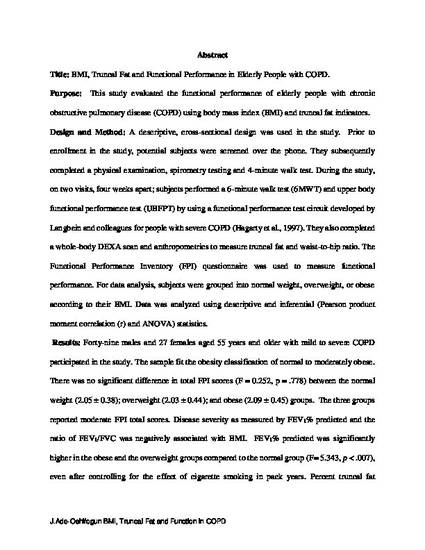
Presentation
Truncal Fat and Functional performance in Elderly People with COPD
Oxford University Round Table Conference
(2013)
Abstract
Purpose: This study evaluated the functional performance of elderly people with chronic obstructive pulmonary disease (COPD) using body mass index (BMI) and truncal fat indicators.
Design and Method: A descriptive, cross-sectional design was used in the study. Prior to enrollment in the study, potential subjects were screened over the phone. They subsequently completed a physical examination, spirometry testing and 4-minute walk test. During the study, on two visits, four weeks apart; subjects performed a 6-minute walk test (6MWT) and upper body functional performance test (UBFPT) by using afunctional performance test circuit developed by Langbein and colleagues for people with severe COPD (Hagarty et al., 1997). They also completed a whole-body DEXA scan and anthropometrics to measure truncal fat and waist-to-hip ratio. The Functional Performance Inventory (FPI) questionnaire was used to measure functional performance. For data analysis, subjects were grouped into normal weight, overweight, or obese according to their BMI. Data was analyzed using descriptive and inferential (Pearson product moment correlation (r) and ANOVA) statistics.
Results: Forty-nine males and 27 females aged 55 years and older with mild to severe COPD participated in the study. The sample fit the obesity classification of normal to moderately obese. There was no significant difference in total FPI scores (F = 0.252, p = .778) between the normal weight (2.05 ± 0.38); overweight (2.03 ± 0.44); and obese (2.09 ± 0.45) groups. The three groups reported moderate FPI total scores. Disease severity as measured by FEV1% predicted and the ratio of FEV1/FVC was negatively associated with BMI. FEV1% predicted was significantly higher in the obese and the overweight groups compared to the normal group (F= 5.343, p < .007), even after controlling for the effect of cigarette smoking in pack years. Percent truncal fat significantly differentiated the normal weight group from the other two groups (F= 28.33, p < .001). Waist-to-hip ratio was significantly and negatively correlated with functional performance (r -.295, p < .001). The mean distance completed by all subjects for the 6MWT was 384.04 (112.00) meters. Mean circuits completed by subjects for the UBFPT was 8.16 (2.36). There were no significant differences in the results of the 6MWT (F = 38.33, p = .578) and UBFPT (F = 2.45, p = .288) among the three groups, even when disease severity and gender were controlled for.
Conclusion: These findings suggest that: (1) truncal fat may be a factor in the performance of daily activities of people with COPD; and (2) mild to moderate obesity may not have any significant detrimental effect on functional performance of elderly people with COPD, though the effect of morbid (severe) obesity was not measured in this study. We anticipate that clinicians will use knowledge derived from this study to improve interventions and plan rehabilitation programs for elderly people with COPD.
Keywords
- Obesity,
- COPD,
- Functional Performance,
- Elderly,
- BMI.
Disciplines
Publication Date
August 7, 2013
Location
Oxford England
Citation Information
Bea Ade-Oshifogun. "Truncal Fat and Functional performance in Elderly People with COPD" Oxford University Round Table Conference (2013) Available at: http://works.bepress.com/bea-ade-oshifogun/15/
